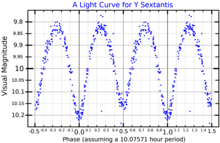 Possible architecture for Y Sextantis' multiple system | |
| Observation data Epoch J2000.0 Equinox J2000.0 | |
|---|---|
| Constellation | Sextans |
| Right ascension | 10 02 47.96897 |
| Declination | +01° 05′ 40.1839″ |
| Apparent magnitude (V) | 9.88 (10.08 + 12.70) |
| Characteristics | |
| Spectral type | F3/5V or F5/6V |
| B−V color index | 0.479±0.072 |
| Variable type | W UMa |
| Astrometry | |
| Radial velocity (Rv) | +13.12±7.76 km/s |
| Proper motion (μ) | RA: +0.282 mas/yr Dec.: +5.112 mas/yr |
| Parallax (π) | 2.5554 ± 0.2972 mas |
| Distance | approx. 1,300 ly (approx. 390 pc) |
| Details | |
| A | |
| Mass | 1.471±0.040 M☉ |
| Radius | 1.568±0.019 R☉ |
| Luminosity | 4.305±0.528 L☉ |
| Temperature | 6,650±163 K |
| B | |
| Mass | 0.287±0.020 M☉ |
| Radius | 0.795±0.017 R☉ |
| Luminosity | 0.979±0.134 L☉ |
| Temperature | 6,448±153 K |
| Other designations | |
| Y Sex, BD+01°2394, HD 87079, HIP 49217, WDS J10028+0106 | |
| Database references | |
| SIMBAD | data |
Y Sextantis, abbreviated as Y Sex, is a variable star system in the equatorial constellation of Sextans. The system is invisible to the naked eye with a mean apparent visual magnitude of 9.88. It is located roughly at 1,300 light years from the Sun based on parallax.

The variability of this system was first announced by C. Hoffmeister in 1934. It was determined to be a short period, strongly-interacting eclipsing binary system. Observations of the light variations up until 1979 were used by G. Hill to generate orbital properties, providing an orbital inclination of 76.8°±0.3°.
This is a multiple star system. The two main components have apparent magnitudes of 10.08 and 12.70, and are separated by 0.50 arcseconds. The brighter component is a W Ursae Majoris variable eclipsing contact binary star system, whose two component stars share a common outer layer. Because the two components share their outer layers as the components of W Ursae Majoris do, they have the same stellar classification, and are classified as yellow F-type main sequence dwarfs. The components take 0.419822800 days (roughly 10 hours) to revolve around common barycentre. Orbital period variations would suggest the presence of additional perturbing objects, one of them likely substellar.
Possible perturbing third and fourth bodies
Orbital period variations suggest the presence of one more perturbing unseen object. The authors He & Qian have estimated two possible orbital periods and minimum masses for unseen companions: the former cyclic oscillation would occur every 51.22 years (with amplitude of 0.0218 days) being caused by a low-mass stellar companion (likely a M dwarf star), whereas the latter would consist in a 32.1 years period and the unseen object could likely be substellar.
| Companion (in order from star) |
Mass | Semimajor axis (AU) |
Orbital period (days) |
Eccentricity | Inclination | Radius |
|---|---|---|---|---|---|---|
| C (unconfirmed) | ≥240 (0.24 Solar masses) MJ | 49.0±3.9 | ≈18695 | — | — | — |
| b (unconfirmed) | ≥43 MJ | 58.9±6.7 | ≈11716 | — | — | — |
References
- ^ Brown, A. G. A.; et al. (Gaia collaboration) (August 2018). "Gaia Data Release 2: Summary of the contents and survey properties". Astronomy & Astrophysics. 616. A1. arXiv:1804.09365. Bibcode:2018A&A...616A...1G. doi:10.1051/0004-6361/201833051. Gaia DR2 record for this source at VizieR.
- ^ Anderson, E.; Francis, Ch. (2012). "XHIP: An extended hipparcos compilation". Astronomy Letters. 38 (5): 331. arXiv:1108.4971. Bibcode:2012AstL...38..331A. doi:10.1134/S1063773712050015. S2CID 119257644.
- ^ Gazeas, K.; et al. (February 2021). "Physical parameters of close binary systems: VIII". Monthly Notices of the Royal Astronomical Society. 501 (2): 2897–2919. arXiv:2101.10680. Bibcode:2021MNRAS.501.2897G. doi:10.1093/mnras/staa3753.
- Houk, N.; Swift, C. (1999). Michigan catalogue of two-dimensional spectral types for the HD Stars. Michigan Spectral Survey. Vol. 5. Bibcode:1999MSS...C05....0H.
- ^ Deb, Sukanta; Singh, Harinder P. (April 2011). "Physical parameters of 62 eclipsing binary stars using the All Sky Automated Survey-3 data - I". Monthly Notices of the Royal Astronomical Society. 412 (3): 1787–1803. arXiv:1011.2574. Bibcode:2011MNRAS.412.1787D. doi:10.1111/j.1365-2966.2010.18016.x. S2CID 118240946.
- ^ He, Jia-Jia; Qian, Sheng-Bang (2007). "An Orbital Period Investigation of the WUMa-Type Binary Y Sextantis". Publications of the Astronomical Society of Japan. 59 (6): 1115–1119. arXiv:0908.4521. Bibcode:2007PASJ...59.1115H. doi:10.1093/pasj/59.6.1115.
- "Y Sex". SIMBAD. Centre de données astronomiques de Strasbourg. Retrieved 2021-04-08.
- "ASAS All Star Catalogue". The All Sky Automated Survey. Retrieved 8 December 2021.
- Koch, R. H. (January 1974). "Blue CN-absorption measurements of close binary stars". Astronomical Journal. 79: 34–41. Bibcode:1974AJ.....79...34K. doi:10.1086/111526.
- Koch, R. H. (February 1961). "Times of minimum light for several eclipsing binaries". Astronomical Journal. 66: 35. Bibcode:1961AJ.....66...35K. doi:10.1086/108355.
- Hill, G. (1979). "Description of an eclipsing binary light curve computer code with application to Y Sex and the W UMa code of Rucinski". Publications of the Dominion Astrophysical Observatory Victoria. 15: 298–325. Bibcode:1979PDAO...15..297H.
| Constellation of Sextans | |||||||||||||
|---|---|---|---|---|---|---|---|---|---|---|---|---|---|
| Stars |
| ||||||||||||
| |||||||||||||
| Galaxies |
| ||||||||||||
| |||||||||||||